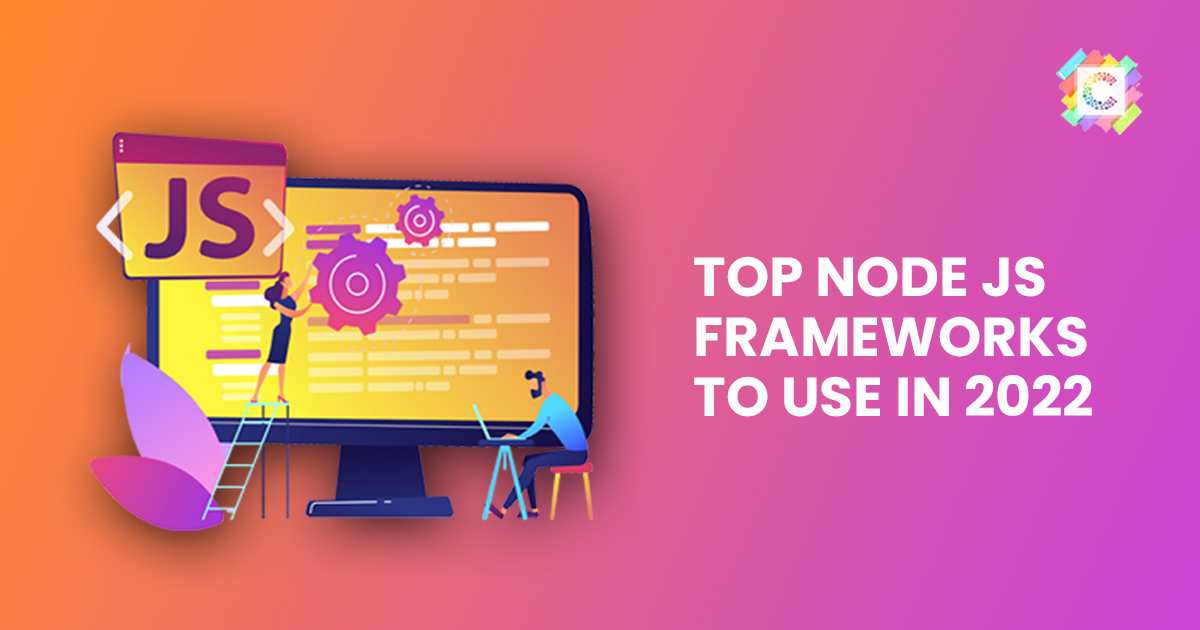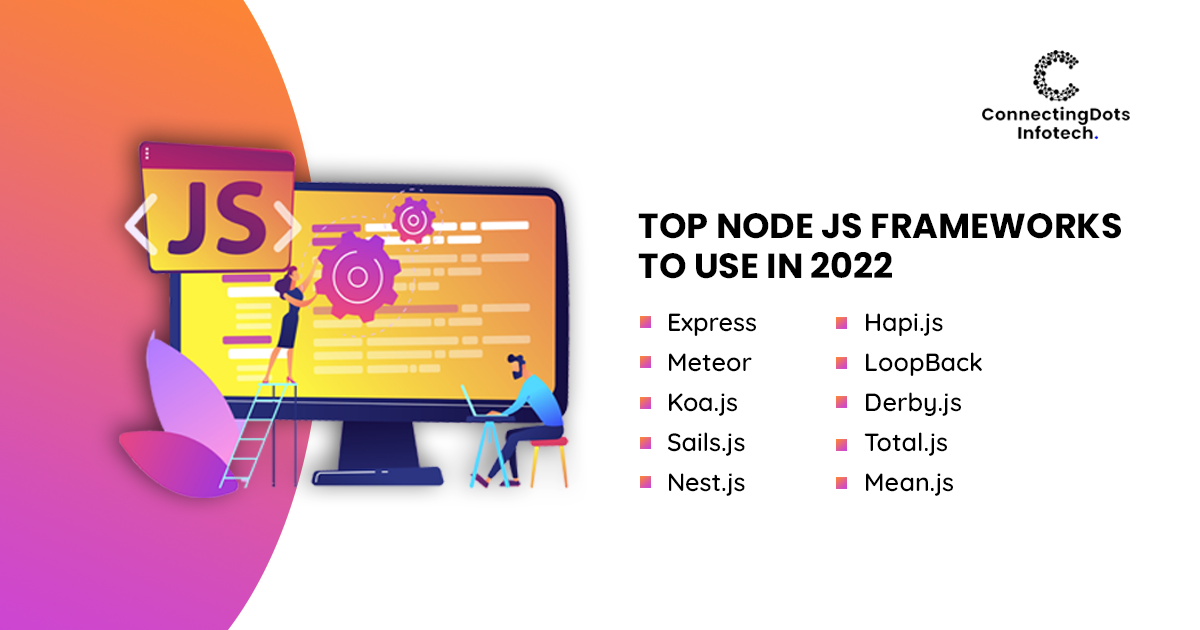Top 10 Node JS Frameworks To Use In 2022

The demand for web applications is expected to grow in 2022, as more organizations adopt them to provide a better user experience. Developers are constantly exploring different frameworks that offer additional functionalities to construct web applications in response to this expanding demand. When a technology is as successful as Node.js, however, it usually has a vibrant developer community that is continually creating and promoting new frameworks. As a result, choosing the proper framework can be difficult, especially when there are a lot of options. But, don't worry, we'll help you out. Read on to learn about the best Node JS frameworks and see which one is ideal for you.
Best Node JS Frameworks:
What is the Node JS framework or library?
A framework is a set of modules, pre-written codes, libraries, and other elements used to create dynamic web applications. When we don't want to construct an application from scratch, web frameworks enter the picture. Instead, we just use a web framework and develop a web application with the help of its elements.
With Node.js, you can create scalable, high-performance sites and applications by using a framework that includes fundamental architecture design, template engines, and inbuilt libraries. They make the creation of server-side web applications easier and faster.
The Node JS frameworks handle placeholder pieces in an abstract design. To create a complete web application, you simply need to type in your own code. It looks after the majority of the application's structure. They also assist developers in defining the web application's control and data flows.
How many Node JS frameworks are there?
There are 3 types of Node JS frameworks, they are:
1. MVC frameworks
MVC frameworks provide a useful design pattern for breaking down application logic into 3 sections: models, views, and controllers. It's a lot easier to maintain and scale the software when development issues are separated.
2. Full-stack MVC frameworks
Full-Stack MVC frameworks provide a lot of scaffolding, modules, template engines, and other development features while constructing a real-time project. They can also handle application development on both: the front-end and backend.
3. REST API frameworks
The Node.js frameworks have a solid reputation for building apps faster using a ready-to-use and well-known REST API. This implies you won't have to bother about network app architectural features.
Here is our list of the Best Node JS Frameworks for 2022:

#1. Express
GitHub Ratings: 46,797
Type: MVC framework
With the most GitHub ratings, Express is perhaps the most popular, quick, and MVC-based framework. It comes with a variety of libraries and elements that work together with Node JS to create stunning and powerful dynamic web apps.
The prominent JS framework is not only restricted to web apps; it can also be used to create increasingly popular mobile-based web applications. It can also be used to create and surf APIs for web pages. ExpressJS comes with all of the HTTP utility functions, methods, and components that developers need to create reliable APIs.
#2. Meteor
GitHub Ratings: 41,509
Type: Full-stack framework
Meteor is a full-stack framework that allows you to build real-time web and mobile apps. It's a cross-platform framework that works on iOS, Android, and the desktop. MeteorJS has the ability to integrate with other prominent systems such as front-end frameworks and database tools like Vue, React, Angular, and MongoDB, to name a few.
Meteor is more similar to the JavaScript syntax than other Node JS frameworks, making it easier to grasp and learn for JS developers. That is why many developers use Meteor.js for back-end development because it allows them to program the entire website with just one programming language.
#3. Koa.js
GitHub Ratings: 28,232
Type: MVC framework
Because it is an MVC framework designed and built by the Express developers, Koa may be considered an extension of the Express framework. The major goal of Koa is to provide a framework that is lighter than Express and capable of faster development of web apps and APIs.
Despite having fewer libraries and components than Express, Koa.js includes a lot of new functionality. Koa's error handling capacity is significantly superior to that of the Express framework.
#4. Sails.js
GitHub Ratings: 21,087
Type: MVC framework
The Express framework is comparable to SailsJS. Despite this, several developers, including Sails, claim that it is superior to Express. This is primarily due to the fact that it includes numerous functions that Express does not. If we compare Sails.js vs ExpressJS using features as the key criterion, the former offers more promise.
Sails is a Node JS framework that is lighter and faster than Express. It's also one of the greatest Node JS frameworks because of its integration with a variety of popular backend and frontend technologies. It has an ORM feature that allows it to work with any database system, including MySQL, PostgreSQL, MongoDB, Redis, and local disk.
#5. Nest.js
GitHub Ratings: 22,912
Type: REST API framework
TypeScript is the core programming language used by Nest.js. It is a Node JS Rest API framework for creating scalable and efficient server-side applications. TypeScript, its native language, gives it powerful features including functional programming, object-oriented programming, and functional reactive programming. Nest.js also has a command-line interface (CLI) that programmers can use to link it with other frontend tools.
#6. Hapi.js
GitHub Ratings: 11,933
Type: MVC framework
Hapi is a strong and reliable Node JS framework created by Eran Hammer at Walmart in 2011. We can create sophisticated APIs and server-side programming apps with hapi. It is also called the server framework, and it enables data to move data between the client and the server through APIs. Express is comparable to Hapi, however, it has fewer functions. Some developers even recommend hapi as a good alternative to Express, however, it lacks a large community.
#7. LoopBack
GitHub Ratings: 12,990
Type: REST API framework
LookBack is a Rest API open-source framework for building dynamic and sophisticated REST APIs. It also comes with a simple command-line interface that makes it easy to combine with other front-end technologies. It allows interaction with several databases, including relational and NoSQL database systems like MongoDB, MySQL, Oracle, and PostgreSQL, because it can be used to develop REST APIs.
#8. Derby.Js
GitHub Ratings: 4,465
Type: Full-stack framework
Derby is a Node JS framework that can be used to create modern online apps. It's a great framework for creating both desktop and mobile web apps. Even though it has a tiny community at the moment, the Node JS framework has a lot of potential. Data synchronization, real-time parallelism, API, and the ability to construct dynamic web pages are just a few of the capabilities it offers.
#9. Total.js
GitHub Ratings: 4,027
Type: MVC framework
It's an MVC-based framework for building web applications and real-time applications. Total.js was released in 2013 with the primary goal of creating a framework that is complicated, stable, and free of dependencies. It includes a number of libraries, modules, and other components developed entirely in Total.js.
#10. Mean.js
GitHub Ratings: 11,839
Type: Full-stack framework
Mean.js is an MVC-based full-stack Node JS framework designed to give cloud-native JS applications an easy and enjoyable starting point. MEAN stands for MongoDB, Express, Angular 6, and Node. All these tools are used in most of the popular technologies today.
How to Choose a Good Node JS Framework?
Since the framework market is volatile, no one can anticipate how these Node JS frameworks will fare in the future. Please don't pick a framework entirely on the basis of its GitHub ratings. Instead, pick one that has a lot of potential and check all of your project's boxes.
For the time being, the aforementioned Node JS frameworks are the finest. We recommend using a framework like MongoDB or Angular that is simple to understand and can be combined with modern trending tools.
Conclusion
Each framework contains characteristics that distinguish it from the others. So, in 2022, you can update your JavaScript expertise with back-end technologies and construct dynamic web applications using any of these tools. We hope that this article has helped you find the right framework for your work or project.
